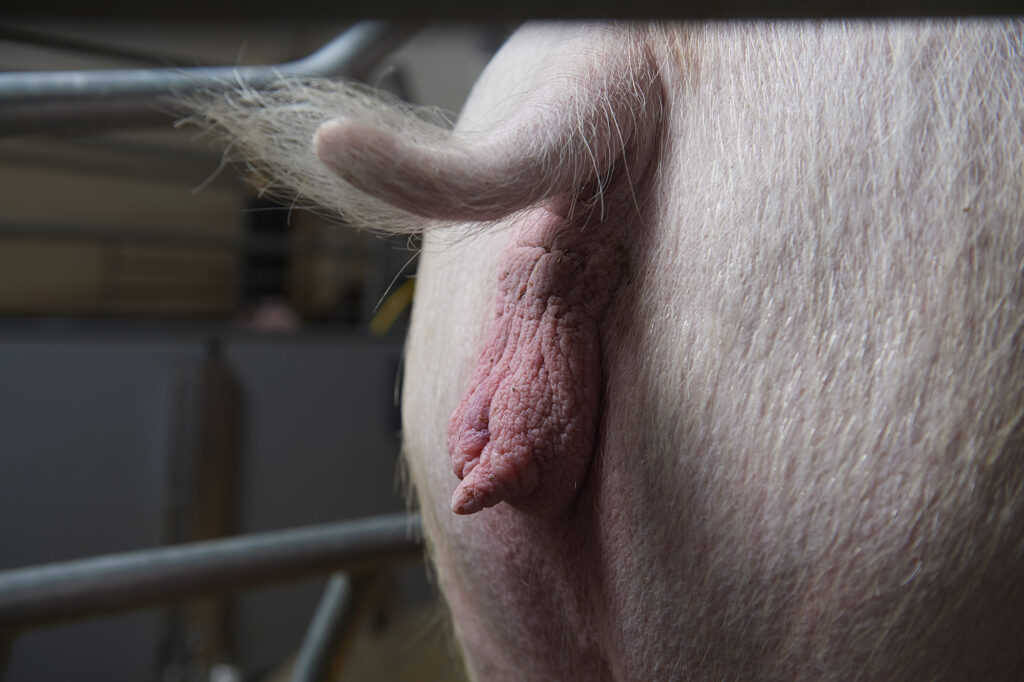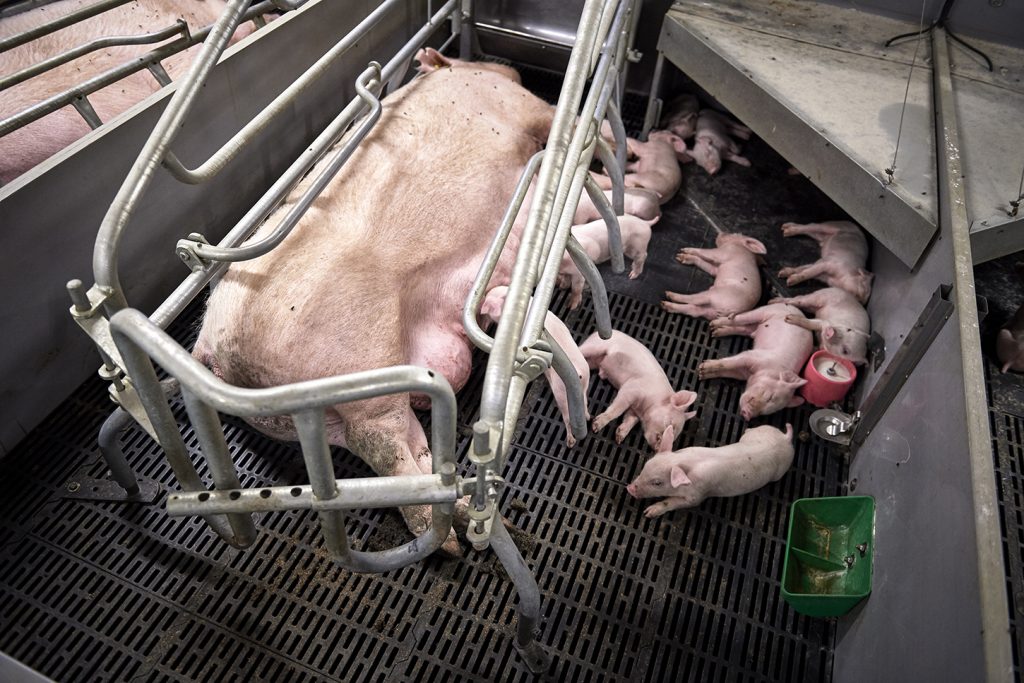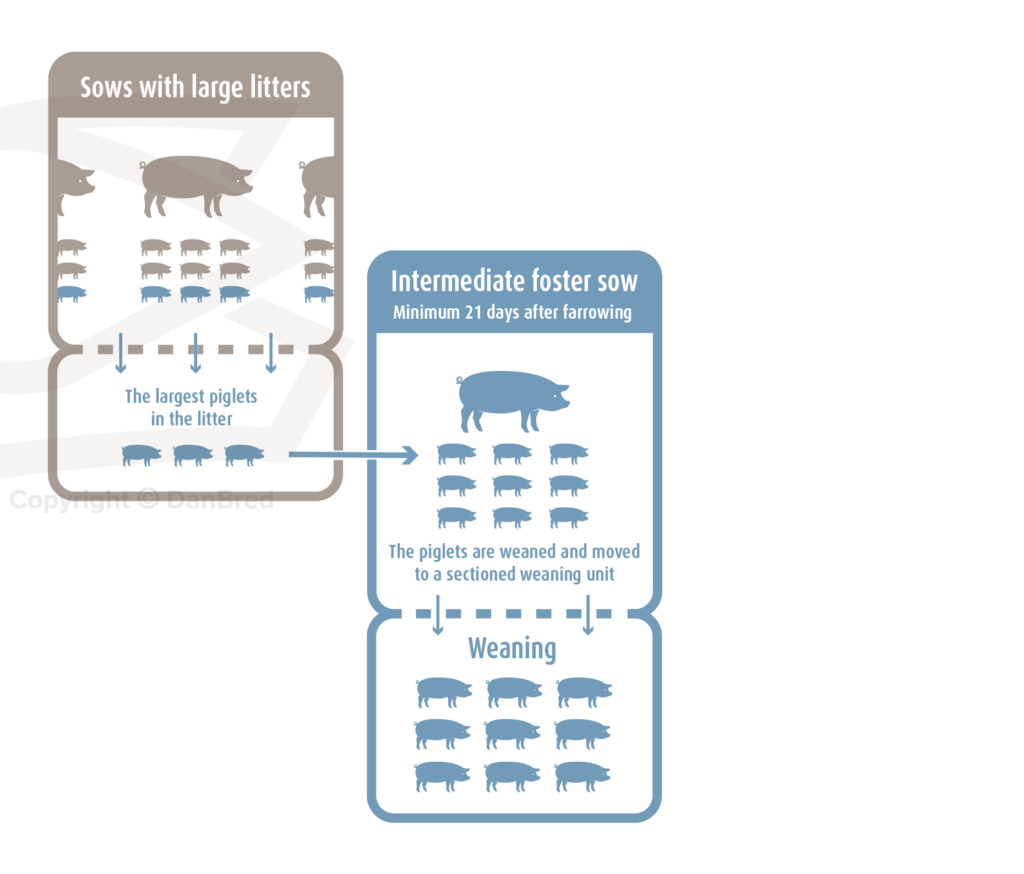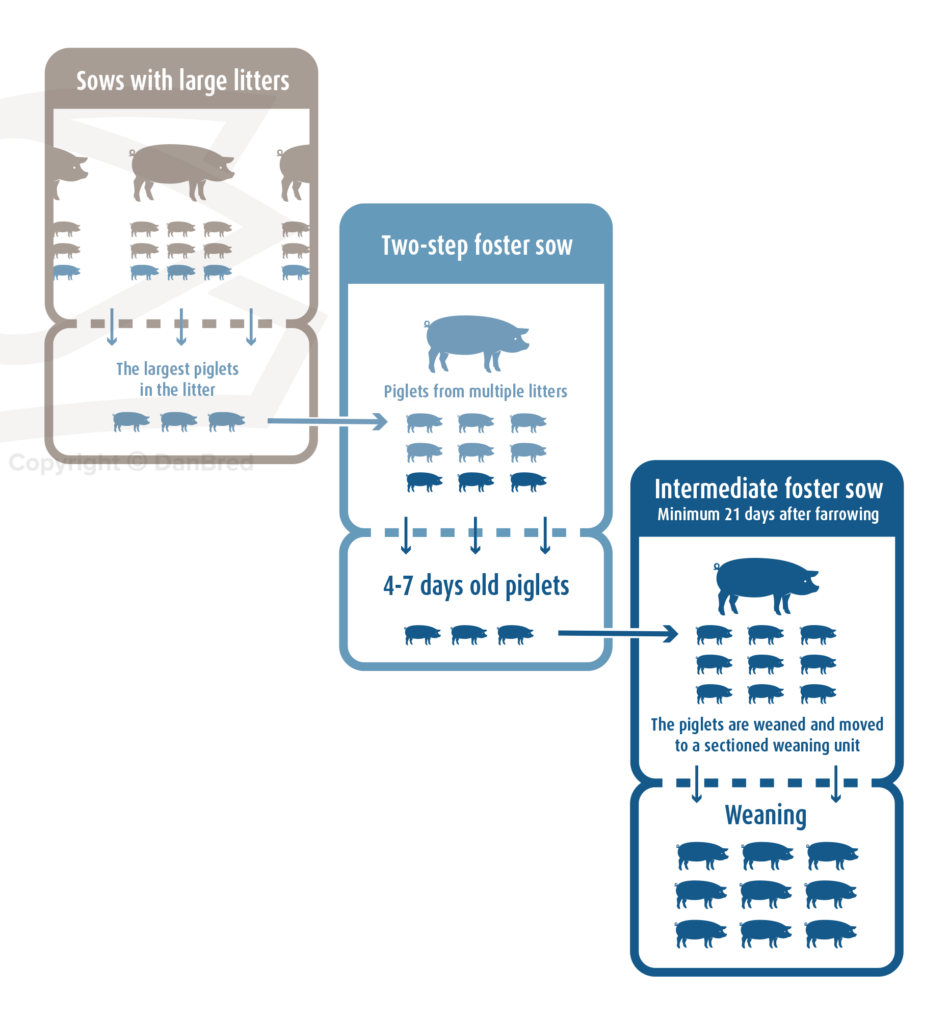Farrowing unit – pre-farrowing
It is in the farrowing unit that you see the results of good preparation during mating and gestation. At least one week before farrowing, move the sows to the farrowing unit.

Make sure you pay extra attention to the sows just before farrowing. It is imperative that during the first 24 hours after farrowing, you make sure all the piglets have been given colostrum and are thriving.
Moving gilts and sows from gestation to the farrowing unit
At least one week before farrowing move the sows and gilts into the farrowing unit.
- Make sure the farrowing pens are clean and dry
|
|
|
- Check and clean the water nipples or drinkers and make sure the water flow is correct
- The recommended water flow is at least 4 litres/minute when 20% of the nipples/drinkers are in use
- Make sure the piglet creep area is heated prior to farrowing
-
- The recommended temperature is at least 34ºC. An electronic thermometer is a recommended management tool to check this

After you have moved the animals, make an assessment of each sow: check the udder and count the number of functional teats. You can then decide how many piglets you expect each sow can take care of as the nursing period approaches.

Make a note of this in the sow card placed above/by the pens. The assessment and the note will help you with litter equalisation.

The environment around the sow is key to successful farrowing. The pens should of course be clean, but it is the temperature that can have a decisive influence on the piglets’ condition. If the piglets are too cold at birth, the stress it causes increases the risk of disease, crushing and even death.
It is a good idea to use heat lamps behind the sow during farrowing so that the piglets are not exposed to cold stress at birth. Piglets born into a heated environment do not have to use as much energy to maintain their body temperature. This gives the piglets more energy to reach the udder and start their intake of colostrum, boosting their immune system and decreasing the risk of death. Additionally, a smooth transition from birth to suckling has been shown to increase weight at weaning.

Make sure you remove the heat lamp when farrowing is over, otherwise the piglets might start using the area behind the sow as a preferred place for resting. Train the piglets to use the creep area instead.
Signs of imminent farrowing
- Swelling of the vulva
 |
 |
- Sows are restless and will show nest-building behaviour around two days before the expected farrowing

- When milk let-down is seen (When a ray of milk can be milked out), expect farrowing within 12 hours

Surveillance around farrowing
Particularly on days when you expect many sows to farrow, we recommend checking the sows at least once an hour during a 24-hour day. There’s no need to help the sows unless they need it, but bear in mind that the first four piglets should be delivered within two hours and afterwards the interval between each piglet should not exceed 60 minutes.
- If the piglets born are already dry, but the sow is still having contractions, you need to start farrowing assistance

- A high standard of hygiene is essential during farrowing assistance

- Make sure there is free access between the sow and your arm during farrowing assistance – don’t put your arm through the housing equipment. It doesn’t help the sow and increases the risk of injury to you
Prior to farrowing assistance, the housing equipment should be opened so there is a safe work environment – if the equipment is not opened, it increases the risk of employees getting injured if something goes wrong
- Wash the vulva with soap, rinse with plenty of water and wear a sterile glove with gel applied
|
|
|
|
|
|
- After farrowing assistance, let the sow rest
|
|
|
- If no piglets are born during the coming hour start farrowing assistance again
Colostrum
Colostrum is crucial to help the piglets develop a strong immune system. It is essential that every piglet gets enough colostrum from the sow within the first 12-24 hours of life. One way of making sure that every piglet gets the colostrum they need is to use split suckling, which is especially recommended for the smaller or less viable piglets. Start split suckling by keeping the biggest piglets in the creep area so that the small piglets have the udder to themselves. After a period of time, swap the group of piglets, making sure the biggest piglets also get enough colostrum from the sow.
|
|
|
Watch the video below where pig333.com shows how to split suckle.
Source: Pig333, Apr 27, 2023: Split suckling: The importance of the first few hours Pig333 – Split suckling
Creep area training
The piglets should be trained to use the creep area so that they will learn to use it on their own when they are not suckling. This reduces the risk of piglets getting crushed or becoming too cold. Make sure the temperature in the creep area is at least 34ºC and there is no draft. If you use a curtain, make sure it is drawn. We recommend placing a cover over the creep area, and it is a good idea to insulate the floor with mats or install underfloor heating in the creep area.
The creep area training will take some time, but it is time that is well spent seen in terms of future daily gain and a lower mortality rate due to a lower risk of crushing.
You can start creep area training as soon as the sow has finished farrowing:
- Inspect and stimulate the sow to stand, ensuring that she starts drinking and eating
- Keep the piglets in the creep area for around 45 minutes
- When the sow has finished eating and is lying down again, begin the split suckling process
|
|
|
- Use split suckling as part of the 45-minute creep area training
- Carry out creep area training at all feedings for the first two days after farrowing
- Make sure you keep the piglets in the creep area while the sows are standing up

When you check the litter, make sure that no piglets are lying in a cold area during or after farrowing. Warm up cold piglets by placing them in the creep area or by using a heat box, heat wagon or something similar.

Piglets which are okay:
- Will be at the udder or in the creep area
 |
 |
- Are not shaking and do not have “goose bumps”

- Will lie partly or fully on their side with their legs stretched away from their body

Piglets which are cold:
- Will be shaking and/or have “goose bumps”
- Lying alone behind the sow, in a small group or on the sow

- Lie with all their legs tucked under their body

Litter equalisation
After a successful farrowing, you will need to carry out litter equalisation. When you moved the sows to the farrowing unit, you had already decided how many piglets each sow should have after litter equalisation (the number of functional teats).
Move the remaining piglets to foster sows. Make sure that the first parity sows get the same number of piglets as the number of teats they have. Studies have shown that the future milk yield for each teat depends on its use in the first parity. This means that unused teats in the first parity will have little or no milk yield during the second and all subsequent parities. It is essential to implement systematic procedures for litter equalisation and the care of foster sows to make sure you have as many viable and healthy piglets at weaning as possible.

Carrying out litter equalisation
- When all piglets have received enough colostrum 12-24 hours after farrowing
- You can carry out litter equalisation until 48 hours after farrowing, but after that, you shouldn’t move any piglets
- Carry out litter equalisation so that every sow gets the number of piglets she is able to nurse according to your earlier assessment
- First of all, move the bigger piglets from the litter and leave the smaller piglets with their mother
- Make sure the foster sow gets piglets of the same size
- Use second parity sows for the smaller piglets as these sows have smaller teats
- Make as many foster sows as needed – every piglet needs sufficient access to the udder

How to make a foster sow system
The foster sow should be a first or second parity sow in good body condition.
One step foster sow
- Find a newly weaned sow in good body condition – second parity sows are recommended
- Place the bigger piglets from the sows which have farrowed within 12 – 48 hours with the foster sow
- Make sure the piglets have had colostrum with their mother before moving them

Two-step foster sow
- The foster sow has farrowed within the last four to eight days (not a weaned sow)
- The four-to-eight-day-old piglets are moved to a newly weaned sow which is around 21 days past farrowing (intermediate foster sow)
- Reduce the feed allowance of the sow by 2 kg per day
- Place the bigger piglets from sows which have farrowed within 12-48 hours (sows with large litters) with the foster sow (two-step foster sow)
- Make sure the piglets moved have had colostrum from their mother before moving them
- Make sure the foster sow receives the same number of piglets as were removed
- You can place small piglets with the newly farrowed foster sow
- The newly farrowed sow should be a second parity sow
- The smaller piglets must have had colostrum before they are moved
- If you do not use a newly farrowed sow for the small piglets, you can instead place the smaller piglets with a farrowing sow, to ensure colostrum intake. The piglets from the farrowing sows can be moved from the mother to another farrowing sow











